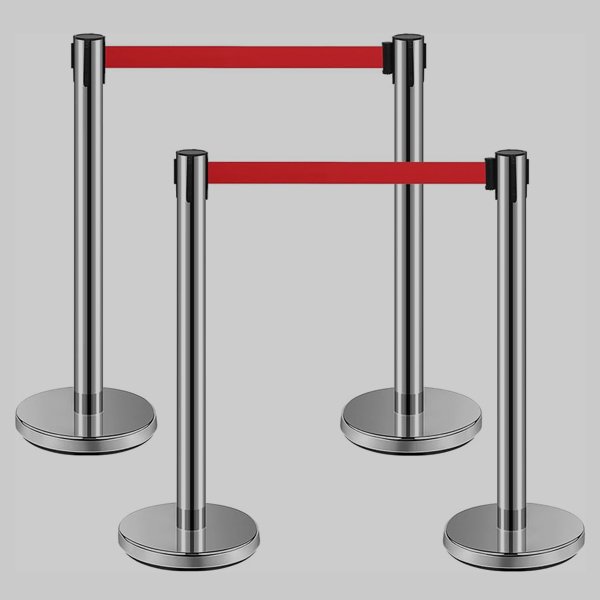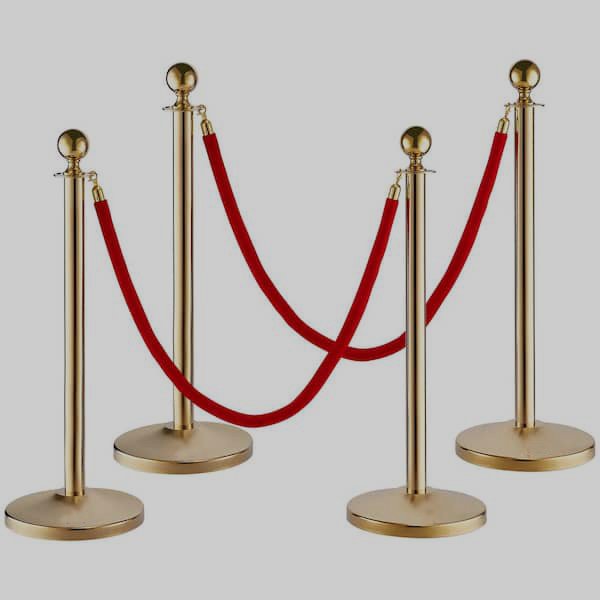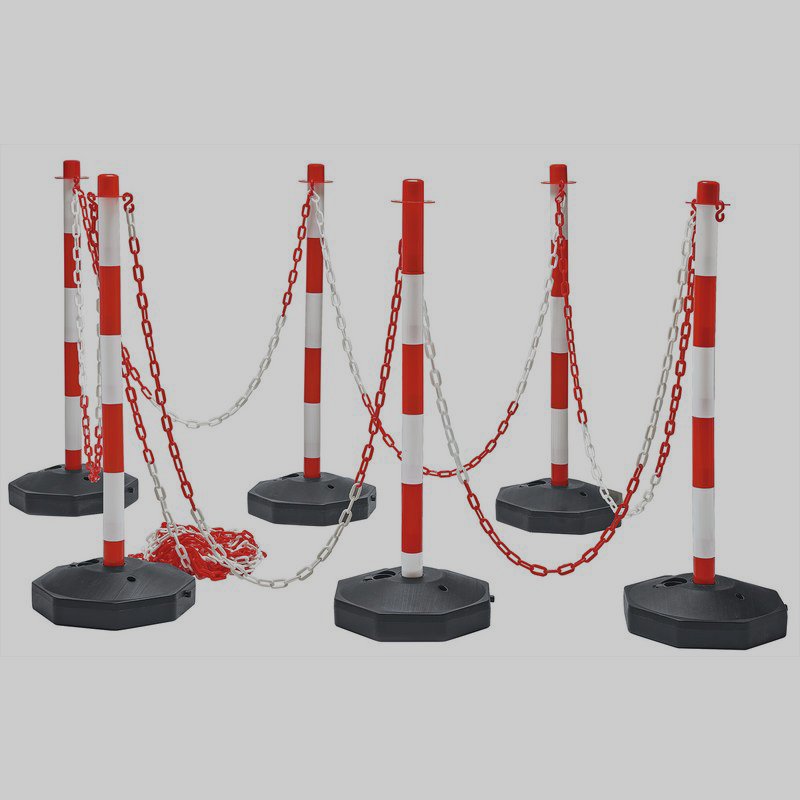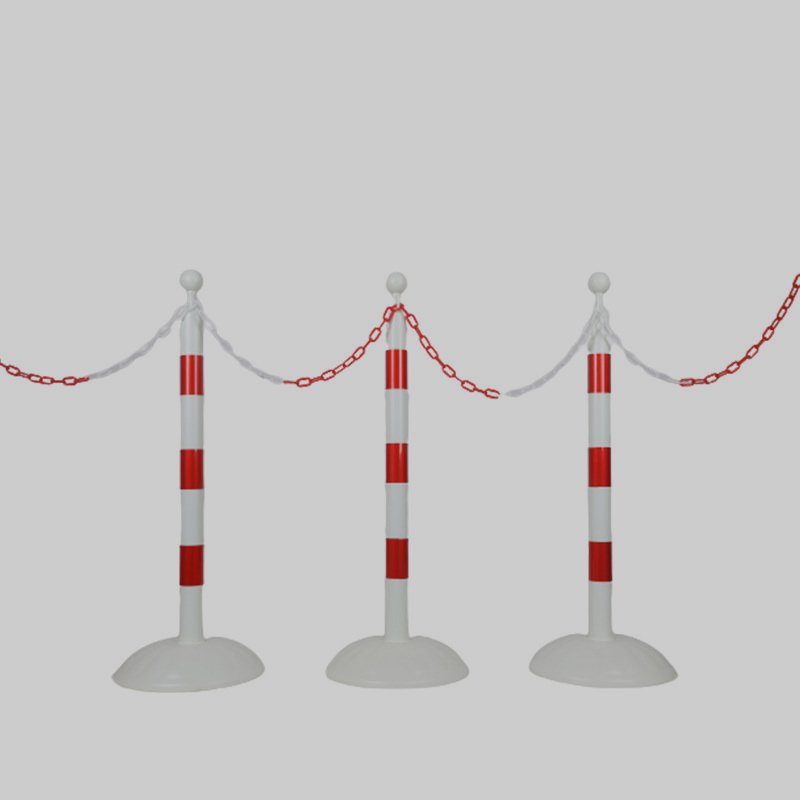Often referred to as bollards, guard posts, or barrier supports, stanchion posts are vertical structures designed to control vehicle and pedestrian traffic, enhance safety, and provide additional support in various situations. Even though they might seem like structural elements, their design, material choice, and installation must be carefully considered in order to guarantee that they adhere to safety standards, endure impacts, and remain durable.
This article will cover in detail the types, advantages, materials, applications, installation techniques, and variables that may impact stanchion posts’ performance.
What is a Stanchion?
Crowds can be effectively managed with the use of a stanchion. It is designed to help with long-term building alterations and to control traffic up to 12 inches (30.48 cm) outside. To show people where they can go safely or when access is restricted, this strong post holds things like ropes, belts, or chains. Stanchions are frequently seen at locations such as airports, ticket booths, check-in desks, and event venues.
They help guide patrons and guests, resulting in more orderly and manageable lines. Stanchions are essential to guaranteeing the security of spectators at stadiums during busy events or big games. By promoting straight lines, they reduce the possibility of dangerous crowds or unexpected surges. Whether they are stationary or made to be movable for convenience, stanchions are useful instruments for guiding people.
Types of Stanchion Posts
Stanchions, commonly referred to as post stanchions, are upright poles that serve to form barriers or assist in managing queues of individuals. These poles typically feature two ropes, belts, or chains. They facilitate the direction and arrangement of individuals from various backgrounds. The primary function of stanchions is to promote efficient and orderly operations, diminish misunderstandings, and enhance safety.
1. Belt Stanchions
A practical device for managing crowds is the belt stanchion. To create orderly lines, retractable belts are situated between upright posts. These setups work especially well in busy spots where crowd management is important, like banks, shops, and airport screenings. The belts often feature easy-to-use mechanisms for pulling and are made from strong polyester or nylon.

They come in various colors to suit different styles. Some designs allow for personalization, enabling logos or patterns to be added to the belt surfaces for advertising purposes. Usually, the posts are crafted from durable materials like colored aluminum or powder-coated steel. This makes them both appealing and sturdy. For stable arrangements in modern environments, they can be placed on strong foundations or supported by the floor.
2. Rope Stanchions
In places where looks are just as important as function, rope stanchions provide a chic and effective option. These setups use high-quality materials, usually made from woven synthetic fibers or velvet-like ropes, alongside shiny metal parts. You will often see decorative features like reflective glass, ribbed columns, or custom engravings on the posts.

This makes them suitable for luxurious hotels, art galleries, exhibition spaces, and retail shops. Thanks to their flexible design, the system can be used in various ways while serving as a subtle yet strong barrier. Many premium versions have weighted bases to keep them stable without compromising their stylish appearance. For busy areas, some models even have the choice to be securely anchored to the ground.
3. Chain Stanchions
Chain stanchions serve as strong and cost-effective emergency barriers. These structures utilize metal mesh chains, which usually do not have added rust resistance, or chains made from highly durable plastic for ease of use. The posts are made of robust metal and are coated for protection, making them ideal for both indoor and outdoor settings.

This setup is especially useful during outdoor events, in educational institutions, and in factories where visibility and durability are important. The chain design creates a noticeable barrier while still allowing for an unobstructed view, and the portable chain stanchions can be easily assembled and taken down. Additionally, commercial-grade lights often come with special features that enhance visibility in low-light conditions.
4. Plastic Stanchions
Plastic crowd control stanchions are a great choice for managing groups temporarily since they are easy to move and use. These systems are usually made from durable materials like polypropylene or polyethylene, which are both strong and easy to handle. The posts often come with hooks to attach belts or ropes, and they usually come in bright, eye-catching colors.

Their modular design makes them ideal for managing events, setting up temporary exhibits, and for use in mobile retail, as they can be easily constructed and taken apart. They can also be stacked easily for storage and transport, and they utilize connected bases to ensure greater stability. Some high-quality flexible plastic stanchions can be customized with different signs or printed designs.
Benefits of using a Stanchion Post
1. Organized Crowd Control
Stanchions are helpful for guiding people, making it easier to create organized lines or designated paths. In places such as stores, banks, quiet areas, or airports, they assist people in knowing where to stand or move. This leads to smoother movement while helping staff manage interactions with customers or monitor safety at entrances and exits.
2. Enhanced Safety
In crowded spaces, focusing on security is crucial. Stanchions keep people from getting too close or rushing, especially during sales, garden events, or emergency evacuations. By creating specific pathways or areas, stanchions reduce the risk of falls, injuries, or dangerous crowd surges. This is essential in settings where many families come together in small areas.
3. Improved Customer Experience
When people enter a venue and can easily see where to go or what to do, they often feel more relaxed and less anxious. Stanchions direct customers towards their goals and provide reassurance while they wait. Clearly defined lines are particularly helpful in locations like banks, coffee shops, and airports, where many individuals might need to wait for a long time. These arrangements help alleviate the frustration of waiting.
4. Flexibility and Portability
Most stanchion posts are designed to be lightweight and easily movable. This feature allows for flexible setups based on your needs—whether that’s daily, weekly, or at regular times. Whether it’s for a short event or adapting to different flow patterns, convenient stanchions enable quick adjustments for outdoor construction or long-term changes.
5. Professional and Polished Appearance
Well-organized stanchion posts improve the look of a space, creating a more professional atmosphere. Sturdy metal posts with retractable belts and stylish velvet ropes add a refined and tidy appearance for high-end events. They demonstrate a dedication to effective task management while also enhancing the safety and experience of your guests or clients.
What are Stanchions Used For?
1. Retail Stores
In busy stores, especially during sales or major events, pole barriers help arrange checkout lines and manage customer movement. They effectively lead shoppers through payment areas and support sections, ensuring everything runs smoothly.
2. Airports and Transportation Hubs
Airports and terminals utilize stanchions to guide people in queues at security checks, ticket counters, baggage claim, and boarding zones. They help maintain order, prevent confusion among travelers, and allow for quicker movement.
3. Banks and Financial Institutions
In banks, poles are used to create clear paths for clients engaging with tellers or financial advisers, ensuring that services are provided fairly and efficiently within a professional setting.
4. Events and Concerts
During large events like concerts, festivals, or sporting competitions, stanchions are used to manage entry points, regulate crowd movement, and keep specific areas apart from general spaces.
5. Museums and Galleries
In museums and galleries, stanchions protect artworks and exhibits by creating barriers that limit visibility. They also direct visitors along a planned route for a well-organized tour experience.
6. Restaurants and Hotels
In restaurants and hotels, stanchions keep lines organized during busy dining times or check-in periods, helping to keep everything calm and tidy.
7. Hospitals and Clinics
In emergency rooms and hospitals, stanchions guide patients to the right check-in spots, laboratories, or treatment areas. They aid in crowd management and help reduce stress in hectic environments.
8. Warning and Hazard Areas
Pole posts equipped with chains or caution signs may be used to block off dangerous zones or restricted areas, helping to keep hikers safe and directing them away from construction sites or ongoing maintenance work. That is the reason it is called stanchion post construction.
Stanchion Components and Choices
- Base Plate
- Mounting Options
- Height & Diameter
- Load Capacity
Materials and Finishes of Stanchion Post
Choosing the right materials and finishes for post stanchions significantly influences their lifespan, appearance, and usefulness. Here is a clear summary of popular options and their suitability for different uses:
Primary Materials
1. Stainless Steel (Grade 304/316)
Uses: High-end marketing venues, humid conditions, food processing settings.
Benefits: Great resistance to rust (particularly 316 due to its molybdenum content, which is effective in salty water), sleek surface, and robust relative to its weight.
Finish Options: has a mirror-like shine, sandblasted with fine droplets.
Care Requirements: Needs regular passivation to keep its chromium oxide layer intact.
2. Carbon Steel
Uses: Technology that offers support with safety measures designed for crash resistance.
Benefits: Extremely sturdy and cost-effective for large projects.
Finishing Options: Hot-dip galvanized (ASTM A123) and powder coating.
Points to Consider: Protective layers are essential in high-wear areas.
3. Aluminum (6061-T6)
Uses: Mobile systems that allow quick setup during events.
Benefits: Disassembles easily, requires a third of the pressure steel does, and won’t create sparks.
Finishing Options: Anodized (Classes I/II) and PVDF coating.
Drawbacks: Not as effective as steel for combat situations.
Barrier Materials
- Material: A center made from woven polyester with a layer of PVC or PU.
- Widths: Common sizes usually fall between 1. 5 inches and 3 inches (38mm to 76mm).
- Stiffness: Breaks occur at weights of 800 to 1,200 pounds (363 to 544 kilograms). UV
- Resistance: Over 500 hours of QUV tests for outdoor use.
Decorative Ropes
- Velvet-covered (12-16 twists)
- Marine-grade woven nylon (3/8 inch to 5/8 inch wide),
- Strong stainless steel cable systems (3mm to 6mm)
- Fittings: Robust brass or metal parts formed by casting.
The surfaces range from glossy, high-quality elements and shining stainless steel for a clean, business-like look to powder-coated choices that offer color, safety, or resistance to weather. Stylish velvet ropes are commonly found in fashionable VIP sections, whereas retractable barriers are available in various colors and styles to align with brands or direct individuals visually. Some other finishes include…
- Patina Finishes
- Electroplated Finishes
- Powder Coating
Installation Methods
Proper configuration ensures safety and power.
- Surface-Mounted: This relies on existing knowledge or information. Easy to set up, but not as secure as traditional alternatives.
- Embedded/In-Ground: Arranged in neat areas and secured tightly with durable concrete. More stable and less prone to shifting.
- Socket-Related Methods allow for the posts to be taken out while keeping a solid foundation. Great for flexible crowd control.
- Burden or Weighted Bases use soil, water, or metal weights for installation. They can be moved easily, but provide less safety than permanent setups.
Standards & Compliance
When choosing and putting up post stanchions, it is vital to adhere to building codes and rules to guarantee safety, functionality, and legal conformity.
- The International Building Code (IBC) provides key guidelines regarding the design, height, and arrangement of structures to ensure that exits remain safe and reachable.
- At the same time, OSHA regulations outline safety standards for workplaces, emphasizing the need for stability and barriers to prevent accidents.
- The ability to bear loads must meet ASTM standards, especially for structural elements like posts and support beams. This compliance ensures they can handle expected loads without breaking.
- Furthermore, safety certifications such as ANSI and TUV confirm that crowd control barriers have been tested for strength and function effectively in public areas. These standards collectively create a solid framework for the design, installation, and upkeep of stanchion systems. This framework guarantees they work properly while prioritizing the safety of the public and following essential guidelines in different settings.
Need Customization Options for a Stanchion?
Jackwin provides simple options for customizing post stanchions and stanchion posts with sign ensuring they match your brand’s style, needs, and surrounding space. Below is a straightforward list of the choices available:
Debossed Logos: Three-dimensional designs that enhance tactile identification (suitable for signs complying with ADA guidelines). This helps businesses strengthen their brand’s identity or improve their presentation at events, shops, or workplaces.
Matte Printing: Bright images printed on plastic materials with special inks that withstand scratches. Need something else? Approach us for your next project diversity.
Key Features to Consider When Choosing Stanchion Posts
Consider the Objective
Think about how you intend to utilize the stanchion, whether it’s for crowd control, organizing queues, indicating boundaries, or merely for aesthetic purposes. This consideration can help simplify the design, such as opting for a retractable belt rather than traditional rope barriers.
Evaluate Your Environment
- For home settings: Standard posts equipped with belts or ropes are effective in places like shops, financial institutions, or locations where people gather.
- For outdoor application: Select robust posts that can endure various weather elements, along with flexible bases and materials that resist fading in sunlight.
Choose the Right Style
- Retractable Belt Stanchions: Perfect for high-traffic areas like airports or major events. Line stanchions fit best in more sophisticated locations such as hotels, nightclubs, or exclusive gatherings with notable personalities.
- Plastic Chain Stanchions: Budget-friendly for establishing designated areas or temporary blockades.
Consider the Base Design
Heavier bases provide enhanced stability in dynamic or noisy settings. Lighter bases are ideal for residential use or for short-term setups when mobility is necessary.
Look at Personalization Choices
You have the option to include branded belts, guiding signs, or color-matched posts to fit your business image or working requirements.
Budget Friendly
Key factors include durability and regular use. Allocating a little extra for higher quality barriers typically yields long-term advantages.
Stanchion Post Price Overview
The price of stanchion posts can vary widely based on the materials used, their specific qualities, and any changes made. The cost of pole posts is affected by many factors, including different designs that are either strong or flexible, which are suitable for various uses. The individual prices can range from $20 to $150 for each post, and there can be problems associated with adjustable retractable belt systems.
When buying a set of four posts, the cost can fluctuate between $300 and $1,000. Additionally, there are premium options like stain-resistant posts, crash-proof models, or smart posts that have sensors. The price for units can range from $200 to more than $3,000, taking into account unique features like trademarks, special finishes, and compliance with ADA standards, along with whether the business is new or well-established. Pricing can be influenced by larger orders often come with discounts.
Factors Affecting Cost:
- Material (plastic vs. stainless steel)
- Customization (logos, colors, engravings)
- Installation (fixed vs. removable)
- Certifications (ADA, ASTM, crash-rated)
Bollard Vs Stanchion Post
Bollard
Why is it called bollard? A bollard is a strong, upright post that helps keep safety and control over traffic, often used to stop or redirect vehicles. Bollards are usually made from tough materials, like durable fabric. They are built to withstand heavy impacts, and some models meet safety standards for crash resistance, which include ASTM and PAS 68.
Generally, they are securely fixed in the ground by being set in concrete for long-lasting use, though there are also movable types available for managing traffic. They are often used to shield shops from taxi crashes, create areas for pedestrians, or manage parking spaces. Bollards offer guidance, safety, and strength, making them important in high-risk locations.
Stanchion Post
A stanchion pole serves as a lightweight, upright post meant to help manage crowds, keep order, or act as an ornamental barrier. Stanchions are often made from metal or flexible substances and commonly come with retractable belts, ropes, or chains to direct pedestrian movement. Unlike bollards, which do not always aim to stop vehicles; instead, they are made to be easily relocated and attractive to look at.
Key Comparison Between Ballard vs Stanchion
Feature |
Bollard |
Stanchion |
| Primary Use | Vehicle impact protection | Crowd guidance/queuing |
| Material | Steel, concrete | Aluminum, plastic, stainless steel |
| Mobility | Usually fixed | Often portable |
| Load Capacity | High (5,000+ lbs impact) | Low (handles human traffic only) |
Difference Between a Column and a Stanchion
A column is a vertical structure designed to hold the weight of something like a building or bridge, directing the loads down to the ground. Buildings often have strong bases built to carry weight.
A stanchion is a vertical post used for tasks like controlling lines (with ropes or belts), creating security fences, or showcasing signs. Stanchions are usually easy to move, light, and meant to aid in service, rather than being exceptionally sturdy or long-lasting.
Conclusion
Post stanchions are versatile devices designed to manage crowds and effectively arrange spaces. Available in several styles, customizable features, and innovative applications, they serve diverse purposes in various locations. When selecting the appropriate pole, it’s important to consider factors such as the surrounding environment, its intended use, aesthetic appeal, and budget constraints. Official backing ensures these stanchions remain sturdy and effective. As we pursue quicker and more sustainable options, post stanchions are expected to evolve, providing enhanced functionalities and improved experiences for users.
FAQs Section
1. Do I need stanchions?
Certainly, they are useful for managing crowds, guiding pedestrians, or establishing orderly lines in an effective manner.
2. What are plastic stanchion posts used for?
These are frequently utilized for temporary crowd management in straightforward or unforeseen locations.
3. Retractable Belt Stanchions or Classic Rope Stanchions
You can opt for retractable belts in busy areas, and select classic rope posts for more formal or elegant settings.
4. What is a post & rope stanchion?
It refers to a popular crowd management solution where attractive posts are linked by decorative ropes.
5. What is a stanchion pole used for?
It serves to create barriers, outline pathways, or divide distinct zones.
6. What are the different types of stanchion posts?
Some common varieties are retractable belt stanchions, line posts, and plastic chain posts.
7. Can plastic stanchion posts be filled?
Indeed, many plastic posts have the option to be filled with sand or water for improved stability.
8. What is a stanchion in the building?
In building terms, a pole is an upright post that offers structural support or serves as a barrier.
9. Do stanchion posts come in different colors?
Yes, they are available in multiple colors and designs to suit your style or visibility requirements.


-80x69.png)

